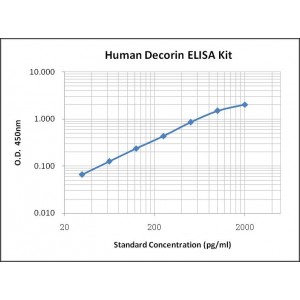More info
Assay Range | 31.2-2,000 pg/mL |
Sensitivity | 10.0 pg/mL |
Specificity | No cross-reaction with other related substances detected |
Size | 96T |
Storage | Store at 2 - 8ºC. Keep reconstituted standard and detection Ab at -20 ºC |
Assay Principle | Sandwich ELISA |
Sample Volume | 100 µL final volume, dilution factor varies on samples |
Detection Method | Chromogenic |
Kit Components
1. Recombinant Human Decorin standard: 2 vials
2. One 96-well plate coated with Human Decorin Ab
3. Sample diluent buffer: 12 mL - 1
4. Detection antibody: 130 µL, dilution 1:100
5. Streptavidin-HRP: 130 µL, dilution 1:100
6. Antibody diluent buffer: 12 mL x1
7. Streptavidin-HRP diluent buffer: 12 mL x1
8. TMB developing agent: 10 mL x1
9. Stop solution: 10 mL x1
10. Washing solution (20x): 25 mL x1
Background
Decorin, also known as PG40 and PGS2, is a secreted chondroitin/dermatan sulfate proteoglycan belonging to the small leucine-rich proteoglycans (SLRPs) family which is characterized by N-terminal and C -terminal cysteine-rich regions which flank the 10 - 12 tandem leucine-rich repeats (LRR) central region. Decorin is an N-glycosylated protein that also carries a variably-sized hybrid chondroitin/dermatan sulfate chain at Ser34. Decorin is subjected to alternative splicing to generate various isoforms. Decorin is degradable in the extracellular space by LRP-mediated endocytosis. Mature human Decorin shares 80% and 78% amino acid sequence identity with mouse and rat Decorin, respectively. Decorin regulates assembly of the extracellular collagen matrix and the bioactivity of the matrix associated growth factors FGF-2, GDF-8/Myostatin, TGF-β, and WISP-1. It can also bind and activate EGF R, ErbB4, and IGF-I R. Decorin has shown multiple functions in promoting myoblast differentiation, supporting angiogenesis, and inhibiting tumor progression.


